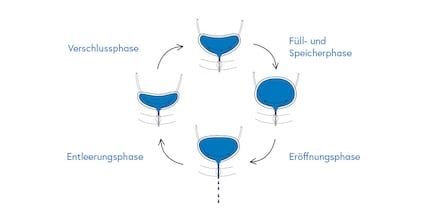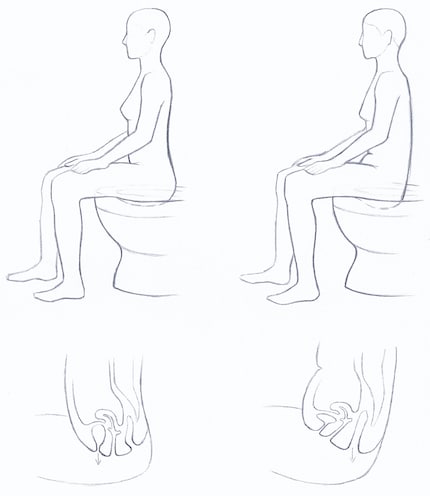
Guide
First aid for pets: what you need to know
by Darina Schweizer

Is holding your pee unhealthy? When’s the right time to use the loo? Is it better to stand up or sit down? In this interview, you’ll learn how to unleash the waterworks without putting your health at risk.
A few years ago, I attended a toilet training course. It’s exactly what it sounds like: learning how to go to the toilet properly. How to absolutely dominate your toilet visit, even. In the process, I realised I knew next to nothing about this bodily function. Worse even, I was doing a lot of things wrong in the bathroom. I listed what I’d learned in an article at the time:
When’s the right time to use the toilet?
When your bladder is decently full. Specifically, between 300 and 550 millilitres of urine. With a recommended water consumption of one and a half to two litres a day, that results in three to five toilet visits. Getting up once at night is okay too.
Does this usually happen when the first signals are sent to the cerebrum?
No, the first signals can already be perceived at 100 to 200 millilitres, reported via receptors in the bladder wall.
So should I just ignore the first signals?
Yep. The bladder is an organ of habit. If you always follow the first signal, you’ll spoil it and will need to use the toilet at ever shorter intervals. Over time, the bladder can no longer hold enough urine, resulting in trained urge incontinence. So think carefully about whether you actually feel the urge to urinate or whether you should go as a precaution.
But how do I know when I’ve reached the recommended urine level?
It isn’t as easy as you’d think and requires good body awareness. If you want to practise this, I recommend keeping a micturition calendar. It’s a kind of diary where you record your bladder activity, drinking and toilet behaviour. This’ll help you get to know your bladder and the need to empty it better.
How much urine can a full bladder hold?
In theory, a capacity of 800 millilitres is still within limits. Then things get dicey. Still, this is only a standard value. Every bladder is different.
I’ve heard that holding your urine stream during urination is a good pelvic floor exercise.
This pee-stop technique was recommended for years as a pelvic floor exercise. However, this is an outdated tip. We now know this exercise can be harmful since it contradicts the function of the bladder.
How so?
Emptying the bladder is triggered by our autonomic nervous system. If this process is repeatedly disrupted, it irritates the organ. In addition, your small urethral sphincter muscle is conditioned to let loose. If it has to work against this need repeatedly, it can lead to bladder emptying disorders.
What role does the pelvic floor play in emptying the bladder?
The pelvic floor is our continence muscle. It’s constantly under basic tension so that no unwanted urine, stool or wind escapes. The pelvic floor muscle helps by relaxing completely during voiding, letting go so that the urine can flow. At the end of micturition, it tightens again so that no urine flows out unintentionally.
Many men like to stand while peeing. Is it unhealthy?
Men won’t suffer if they pee standing up. On the contrary, the slightly hollow back position this creates is ideal for emptying the bladder. The opposite is true for bowel evacuation: a slightly rounded back is best. True, the person who cleans the toilet will usually want men to sit. However, this doesn’t correspond to the natural position for emptying their bladder.
So I don’t need to put my feet up when I pee, unlike when I defecate?
No, this isn’t necessary when peeing. Tip number two: take your time and relax. The opening phase only lasts a brief moment. Give your muscles time to switch from holding back to letting go. You can help by exhaling with an «Aaaah». Another well-known method is to turn on the tap.
Wait a moment! I always thought it was a myth that the sound of running water promotes the urge to urinate?
No myth here. It’s completely true, and recommended by urologists.
What does this mean?
Organs such as the uterus, bladder, urethra or bowel slide downwards. When pressing, the larynx is closed, the diaphragm tenses and is displaced downwards. This leads to downward displacement of the organs in the abdominal cavity. The pelvic floor and the entire suspension of the organs will be heavily strained and overstretched. Organs will be pushed down more and more due to years of pressing.
And your final fourth tip?
Tense the pelvic floor after voiding. When the bladder or bowel is empty, your pelvic floor tenses spontaneously. You can incorporate a daily exercise at this point. After every visit to the toilet, tense your pelvic floor firmly, hold it for a few seconds, then consciously let go. The pelvic floor will then return to its base tension.
As a massive Disney fan, I see the world through rose-tinted glasses. I worship series from the 90s and consider mermaids a religion. When I’m not dancing in glitter rain, I’m either hanging out at pyjama parties or sitting at my make-up table. P.S. I love you, bacon, garlic and onions.
Practical solutions for everyday problems with technology, household hacks and much more.
Show allToday, five years later, I ask myself: how does peeing work? You may laugh now, but do you actually know? I’ve been doing Pilates regularly for two years and can really feel how it’s strengthened my pelvic floor. Even on the toilet. Once I’ve emptied my bladder as usual, I now use my pelvic floor to help squeeze the last bit out of my bladder. A strange habit – and, as I learn in the following conversation, an extremely unhealthy one too. So, how and when do you pee properly? Judith Krucker is an expert in pelvic floor and bladder health and has answers to my questions.
Judith, I’m afraid we’ll have to start our conversation with a bit of theory. What happens in our bodies when we urinate?
Judith Krucker: In our technical jargon, we call the water release mechanism the micturition cycle. In simplified terms, it consists of four steps. In the filling and storage phase, the muscles of the bladder are relaxed and the bladder fills slowly. When it’s about half-full, we perceive the first signals of the urge to urinate. The volume continues to increase and sensitive nerves now signal to the cerebrum that the bladder will soon be full. The pelvic floor increases the tension and thus increases the closing pressure of the urethra to prevent premature bladder emptying.
Does this mean I really should go to the toilet at this point?
Exactly, since this is when the opening phase begins. You’re sitting on the toilet, causing the transition from the urethra to the bladder to widen, resulting in the formation of a funnel in the area of the bladder neck. During the voiding phase, the pelvic floor and muscles of the urethra relax. Now the bladder begins to work, its muscles tensing as urine flows. In the closure phase, urine flow decreases. The muscles of the urethra and pelvic floor tighten again, the funnel formation disappears and the cycle begins again.

Can an overfilled bladder cause damage?
Imagine how much the bladder has to expand to make room for this much urine. The bladder wall is then very thin, and bladder muscles will no longer contract properly for urination. During an extreme stretch, it’s very weak. If more than 550 millilitres of urine regularly accumulate in your bladder, you shouldn’t delay emptying it. Age is another factor – years of overstretching the bladder can lead to overflow incontinence. In short, the bladder overflows.
So, contraction of the bladder muscle isn’t an «active» process I can influence. It happens on autopilot, so to speak?
Yes, the bladder works automatically. Unfortunately, people always try to speed up the emptying process by pushing. This strains the bladder and irritates the process, a neurological, natural reflex. In these cases, the bladder often isn’t completely emptied. Residual urine remains in the bladder, increasing the risk of infections.
Is there a right way to empty the bladder?
Over the years, everyone develops their own toilet technique. However, I recommend four tips generally. The first is a comfortable seat allowing open legs. Sit down, even when you’re out and about. The bladder can’t relax as well in a standing squatting position. In these cases, urine struggles leaving the bladder. The optimum position for emptying your bladder is in a slightly hollow back position.

What’s tip number three?
Don’t push. As we’ve already learned, urination occurs solely through the power of the bladder. Pushing is an enormous strain on your pelvic floor and the ligaments that hold organs such as the uterus, bladder, etc. in place. In addition, the pelvic floor automatically tenses when you push, so the resistance is even greater. Completely emptying the bladder then usually isn’t possible. Women who push several times a day can slightly lower their organs.
What are the consequences of this organ drop?
The problems that can arise as a result are manifold. A lowering exerts pressure on the pelvic floor. You’ll then require additional force to stay «watertight». If the uterus presses on the bladder, it can also affect the flow of urine. A lower bowel can lead to constipation. This organ lowering is really only possible in women. Men have a narrower pelvis and will struggle less with pelvic floor problems.